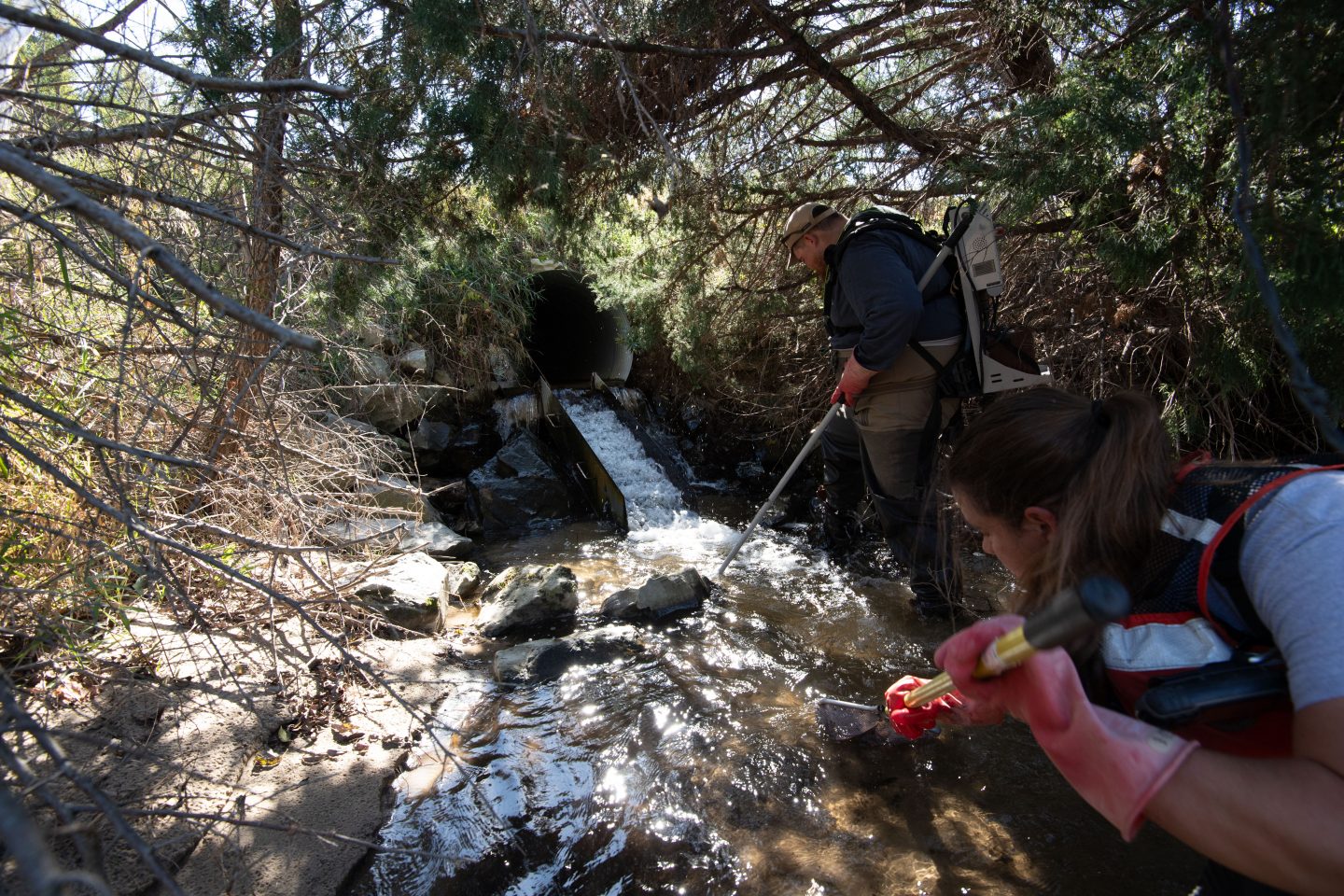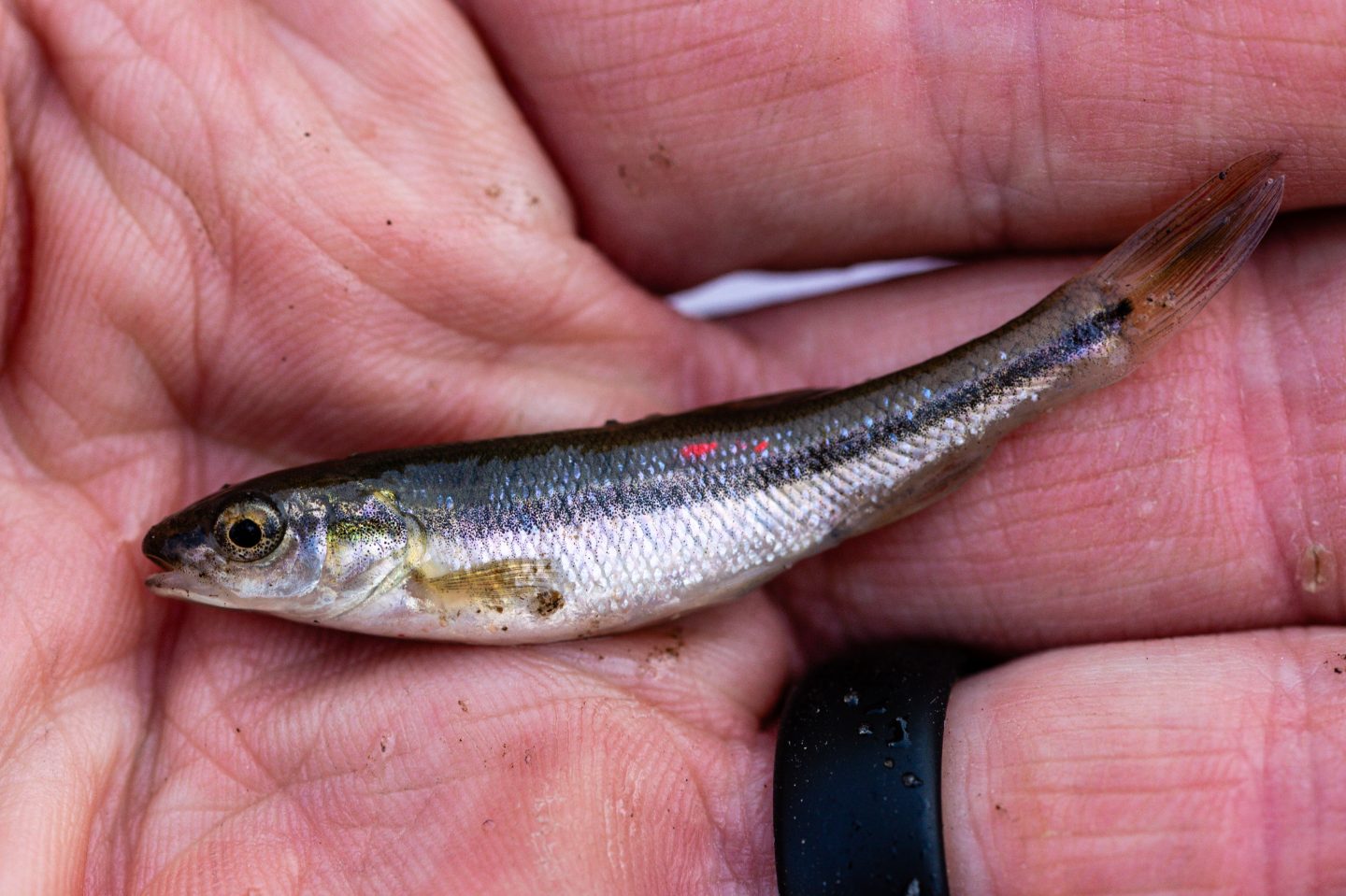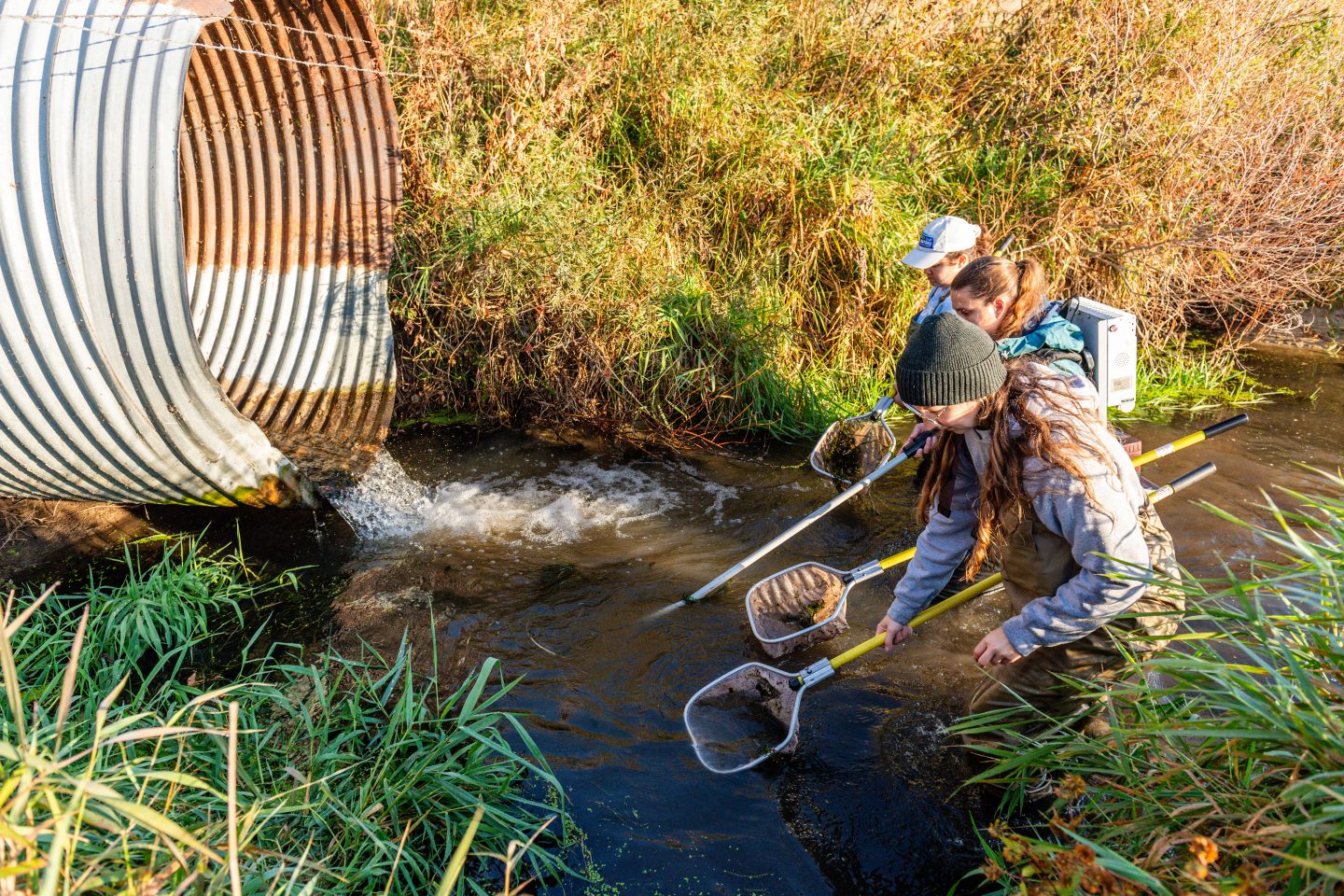
By Eric Fowler
Most everyone knows fish can jump. But there are few species swimming in rivers and streams in Nebraska that can launch themselves 3 feet from a pool into a culvert that runs under a roadway and continue swimming upstream.
Yet in a test run to study the effectiveness of fish ladders installed to bridge that gap, a western blacknose dace, a rare native minnow, was able to navigate a 3-foot drop and keep swimming up Willow Creek north of Newport. The results there and on two other streams that feed the Niobrara River in northeastern Nebraska have Game and Parks Commission fisheries and wildlife staff looking to do more to reconnect streams fragmented by barriers, especially culverts.
Making It Back Upstream
There are more than 16,000 miles of rivers and streams in Nebraska. And 194,000 miles of roads. The two cross more than 110,000 times. Exactly how many of those crossings impede fish movement isn’t known: There has not been a formal study.
At most of these intersections, the rivers and streams flow freely beneath a bridge: There are an estimated 55,000 to 75,000 bridges in the state. On the smaller streams, however, it is often culverts, large or small, that carry the water under roads. Whether they are round sections of corrugated steel or square box culverts made of concrete, culverts are much more economical to install and maintain. When they are installed level to the stream’s flow, fish can swim through them freely. Some, however, are level on the upstream side and drop a few inches to a few feet on the downstream side. When culverts are too small, increased velocities, even under normal flows, can erode the streambed on the downstream side and leave a culvert perched.
Some fish, including larger creek chubs, are capable of making the jump and continuing upstream. For most, however, it is the end of the road. Even when water levels rise to the level of the culvert during heavy rains, stream velocities can be too swift for small fish to navigate.
While some fish spend their entire lives in one section of stream, others need to move to reach spawning or feeding areas. “Most of our minnow species have an innate pull to go upstream, to the extent that they’re able, to find new habitat or for spawning,” said Cassidy Wessel, a Game and Parks wildlife biologist in northeastern Nebraska.

Some are pelagic spawners, releasing their eggs to drift downstream. If those eggs drift through a perched culvert and the young are not able to make it back upstream, it can affect the overall population.
Fragmentation is one of several reasons nine of the 30 native fish found in cool-water streams in Nebraska are listed as endangered, threatened or at risk.
Fish Need a Ladder
The impetus for the study came a decade ago, when Wessel led a survey of at-risk species, such as the northern redbelly dace, on three streams from their headwaters to their confluence with the Keya Paha River.
“We just ran into a lot of potential barriers,” Wessel said.
And there are more barriers today following historic flooding in the spring of 2019, and another round of localized flooding on Long Pine Creek and others in the fall of that year. “Those floods just accelerated what was happening slowly in a lot of streams,” Wessel said. “We were looking around and thinking, ‘My gosh. Is there any way we can help?’”
John Lorenzen, a student at South Dakota State University, was a technician on that survey. Later, for his master’s thesis, he tested several fish ladder designs on perched culverts in the lab and on streams in eastern South Dakota and the Black Hills. What he found was a Denil-type ladder, with a series of flat-topped baffles that allow fish to ascend a short rise and then rest, was the most effective. In lab studies, all 14 species stocked in tanks were able to move up the ladder, and in the field, 23 species did so.
Wessel had followed his work with interest, and in 2020, with funding from the Game and Parks cool-water stream program, had a machine shop in Hartington build a ladder based on Lorenzen’s design, and then installed it on a culvert on a branch of Bone Creek south of Ainsworth, simply as a proof of concept. “Until people can put eyes on it, it doesn’t seem like it’s a real option for them,” Wessel said.
In 2021, Wessel and fisheries biologists identified three stream and road crossings where the ladders could be installed on culverts with varying levels of drop: Bone Creek west of Ainsworth and Willow and Oak creeks north of Newport. That year, they used electrofishing equipment to survey fish populations 150 meters above and below the culverts and then installed the fish ladders with traps at the top to see if any fish ascended them during a one-week period. Heavy rains caused the fish trap on Oak Creek to fail. Just two fish, including the western blacknose dace, were found in the trap on Willow Creek, but that site, with a 3-foot drop, would have been the most difficult for small fish to navigate. On Bone Creek, where the ladder was installed on a 1-foot drop, they found 93 fish. Most of those were white suckers and creek chubs, which have more jumping ability than other small minnows. “Did they jump up the 12-inch drop or did they go up the ladder? I don’t know,” said Joe Spooner, a fisheries biologist. “Regardless, we still caught fish utilizing them. So that answered the question: Will they actually provide the opportunity? Yes.”

Realizing the site on Oak Creek could be problematic, another site was chosen on Sand Draw, a stream northwest of Ainsworth, with a similar 2-foot drop.
Biologists sampled the streams in the spring, summer and fall in 2022 without fish ladders attached, and again in the spring of 2023 before attaching the ladders. Fish received a yellow mark on their side if they were captured above the culvert and red mark if caught below. Without fish ladders, 13 creek chubs and white suckers marked below the culverts were found above them.
Before the ladders were removed in the fall of 2023, sampling found three marked fish that had moved upstream: a creek chub on both Bone Creek and Sand Draw and a western blacknose dace on Willow Creek. The latter, Spooner said, could only have moved via the ladder.
“That’s not to say that fish moved and didn’t continue on up the stream out of our sampling site,” Spooner said, noting that fish may have also swam up the ladder and returned downstream. “I think these fish we were sampling move a lot more than we think throughout the seasons, so the chances of recapturing them was minimal at most.”
More Studies, More Questions
The effects of stream fragmentation on native fish are being studied throughout the world, but Wessel said there is still much to be learned about fish in the Great Plains. Studies like this one, she said, leave biologists asking questions, like why were the fish trying to go up stream, what triggered the movement, and how different would the fish communities be on these streams if everything could get upstream that wanted to?
It also has them asking which fragmented streams could benefit most from fish ladders. Wessel and Spooner are now looking for those streams, as well as stream restoration projects to address erosion below barriers. Work will likely focus on the Niobrara River basin, which is home to a high percentage of both cool-water streams and imperiled fish species. A stream with rare native fish, and lacking non-native species, where several barriers could be bridged with ladders to reconnect several miles of streams, would be ideal. South Dakota State has resumed fish ladder research and is looking at ways to use pit tag readers to monitor fish movement that would provide more reliable data.

Facilitating fish movement throughout fragmented streams could become increasingly important as climate change progresses. Warming temperatures could increase the use of groundwater, which is the primary source for all of the state’s cool-water streams. Further declines could reduce stream flow and increase water temperature. If a section of stream were to dry up above a perched culvert, there would be no way fish could repopulate it on their own, Spooner said.
“I’ll guarantee we’d be very, very hard pressed to find any stream in Nebraska that doesn’t have two or three significant barriers along it somewhere,” Wessel said. “Some fish are going to be able to make those small leaps, but we have some that are probably just quite terrible jumpers. Even where it is just a small drop, that can still mean something for some species.”
And for species like the blacknose shiner and Topeka shiner, listed as endangered in Nebraska, the threatened finescale and northern redbelly dace, or the northern pearl dace, western blacknose dace, plains topminnow and other species at risk of making those lists, something could mean everything.
